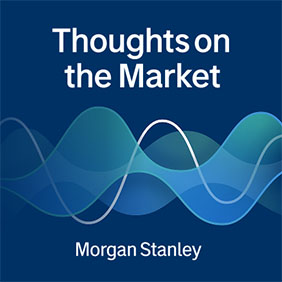Credit Market’s Three Big Debates
October 16, 2025
With Morgan Stanley’s European Leveraged Finance Conference underway, our Head of Corporate Credit Research Andrew Sheets joins Chief Fixed Income Strategist Vishy Tirupattur to discuss private credit, M&A activity and AI infrastructure.

-
 Andrew Sheets
Andrew Sheets
-
 Vishy Tirupattur
Vishy Tirupattur
Thoughts on the Market
Listen to our financial podcast, featuring perspectives from leaders within Morgan Stanley and their perspectives on the forces shaping markets today.

Up Next
Asia’s Youth Job Crisis
Transcript
Welcome to Thoughts on the Market. I’m Chetan Ahya, Morgan Stanley’s Chief Asia Economist.
Today – Asia’s young workforce is facing a significant challenge. How a soft labor market will shape everything from consumer demand to social stability and long-term growth.
It’s Tuesday, October 14th, at 2pm in Hong Kong.
Across Asia, a concerning trend is emerging. The region’s younger generations face mounting challenges in the job market.
Asia’s youth unemployment averages 16 percent, which is much higher than the U.S. rate of 10.5 percent. Youth unemployment rates are running two to three times higher than headline unemployment rates. The underlying situation is even weaker than what is represented by [the] unemployment rate.
And within Asia, the challenge is most acute in China, India, and Indonesia, the three most populous economies. Youth unemployment rates for these three economies are running close to double, as compared to other economies in Asia.
Now let’s take a closer look at China. The urban youth unemployment rate, i.e. for 16–24-year-olds, has steadily increased since 2019.
What’s driving this rise in unemployment? A mismatch in labor demand and supply. The number of university graduates surged 40 percent over the last five years to close to 12 million. But economy-wide employment has declined by 20 million over the same period. Entry-level wages are sluggish, and automation plus subdued services growth mean fewer opportunities for newer entrants.
Turning to India, their unemployment rate is the highest in the region at 17.6 percent. Employment creation has been subdued. And on top of it, India also faces another issue: underemployment. Post-COVID, primary sector – i.e. farming and mining – employment rose by 50 million, reaching a 17-year high. Note that these jobs are relatively low productivity jobs. And this is explained by the fact that [the] primary sector now accounts for less than 20 percent of GDP but it employs about 40 percent of the workforce. That’s a sign of COVID-induced underemployment.
How fast must growth be to tackle the unemployment challenge? In our base case, India's GDP will grow at an average of 6.5 percent over the coming decade – and this will mean that India will be one of the fastest-growing economies globally. But this pace of growth will not be sufficient to generate enough jobs. To keep [the] unemployment rate stable, India needs an average GDP growth of close to 7.5 percent; and to address underemployment, the required run rate in GDP growth must be even higher at 12 percent.
Shifting to Indonesia, its youth unemployment rate is the second highest in the region. Moreover, close to 60 percent of jobs are in the informal sector. And many of these jobs pay below minimum wage. Similar to India, both these trends signal underemployment. The key reason behind this challenge is weak investment growth. Indonesia's investment-to-GDP ratio has dropped meaningfully over the last five years.
So, what’s the way forward? For China, shifting towards consumption and services could reduce labor market mismatches. And for India and Indonesia, boosting investment is key. India in particular needs much stronger growth in its industrial and exports sectors. If reforms fall short, policy makers may need to fall back on increasing social welfare spending to manage social stability risks.
Thanks for listening. If you enjoy the show, please leave us a review wherever you listen and share Thoughts on the Market with a friend or colleague today.

How Politics Affect Global Markets
Transcript
Arunima Sinha: Welcome to Thoughts on the Market. I'm Arunima Sinha, from Morgan Stanley's Global and U.S. Economics teams.
Today, I'm going to talk about sovereign debt outlooks and elections around the world.
It's Wednesday, October 15th at 10am in New York.
Last week we wrote about the deterioration of sovereign debt and fiscal outlooks; and right on cue, real life served up a scenario. Elections in Japan and another political upheaval in France drove a reaction in long-end interest rates with fiscal outlooks becoming part of the political narrative. Though markets have largely stabilized now, the volatility should keep the topic of debt and fiscal outlooks on stage.
In Japan, the ruling Liberal Democratic Party, the LDP, elected Sanae Takaichi as its new leader in something of a surprise to markets. Takaichi's election sets the stage for the first female prime minister of Japan since the cabinet system was established in 1885.
That outcome is not assured, however. And recent news suggests that the final decision is a few weeks away. The landmark movement in Japanese post-war politics, in some ways further solidifies the changing tides in the Japanese political economy. Markets have positioned for Takaichi to further the reflation trade in Japan and further support the nominal growth revival.
The Japanese curve twists steepened sharply as Tokyo markets reopened with the long-end selling off by 14 basis points amid intensifying fiscal concerns and the unwinding of pre-election flattener positions. Specifically, expectations appear to be aligning for a more activist fiscal agenda – relief measures against inflation, bolstered investment in economic security and supply chains, and stepped-up commitments to food security.
Our strategists expect that sectors poised to benefit will include high tech exporters, defense and security names, and infrastructure and energy firms, as capital is likely to rotate towards these areas. Though, as our economists cautioned, the lack of a clear legislative maturity may hamper efforts for outright reorientation of fiscal policy.
Meanwhile, we expect the implications for monetary policy to be limited. Our reading is that Taikaichi Sanae is not strongly opposed to Bank of Japan Governor Ueda’s cautious stance reducing expectations for near term hikes. But we also reiterate that a hike late this year remains a possibility, particularly as the yen weakens.
Economically, our baseline call has been supported by the election outcome given we did not expect the BoJ to raise rates in the near future. Indeed, market expectations of an increase in interest rates have been priced out for the next meeting.
France is the other economy that saw long-end rates react to political shifts since we published our debt sustainability analysis. PM Lecornu's resignation was far quicker than markets expected, especially given the fact that he was only in office for a matter of weeks.
A clear majority in the current parliament remains elusive pointing to continued gridlock, and ultimately snap elections remain a possibility for the next weeks or months. At the heart of the political uncertainty is division about how to proceed with fiscal consolidation against a moving target of widening deficits.
The lack of fiscal consolidation in France has been a topic for many years. Though the ECB provides an implicit backstop against disruptive widening of OAT spreads through the TPI, our Europe economists view the activation of TPI as unlikely. As the spread widening has been driven by concerns around France's fiscal sustainability, a factor that is likely seen as reflecting fundamentals.
In our rather mechanical projections on debt, we highlighted markets would ultimately determine what is and is not sustainable. These political events are the type of catalyst to watch for.
So far, the risks have been contained, but we have a clear message that complacency could become costly at any time. With the deterioration in debt and fiscal fundamentals, we suspect there will be more risks ahead.
Thanks for listening. If you enjoy the show, please leave us a review wherever you listen and share Thoughts on the Market with a friend or colleague today.

Sign up to get Morgan Stanley Ideas delivered to your inbox.
Thank You for Subscribing!
Would you like to help us improve our coverage of topics that might interest you? Tell us about yourself.



